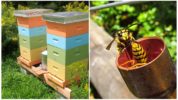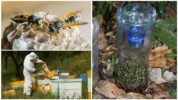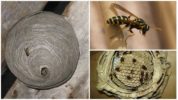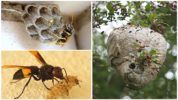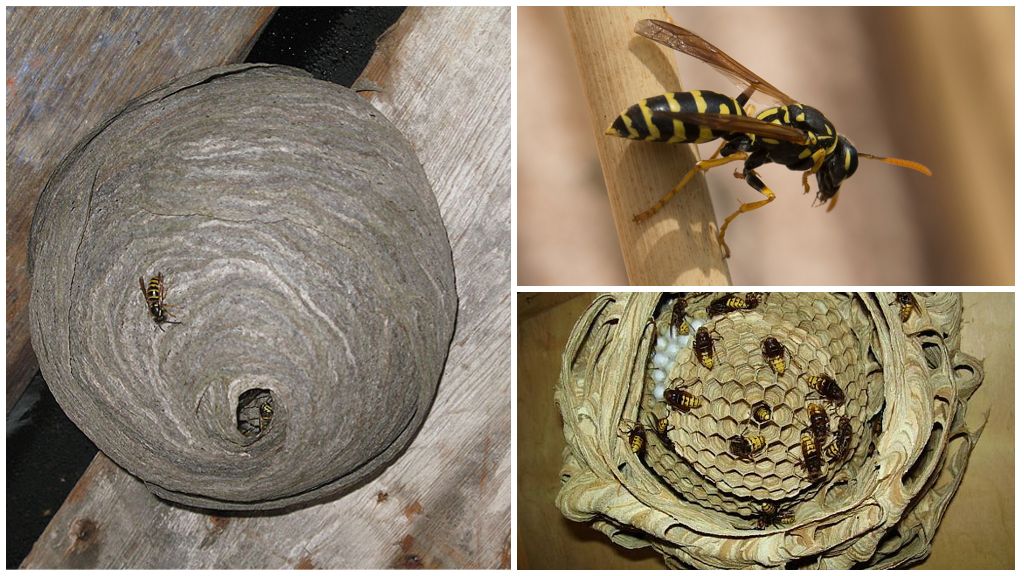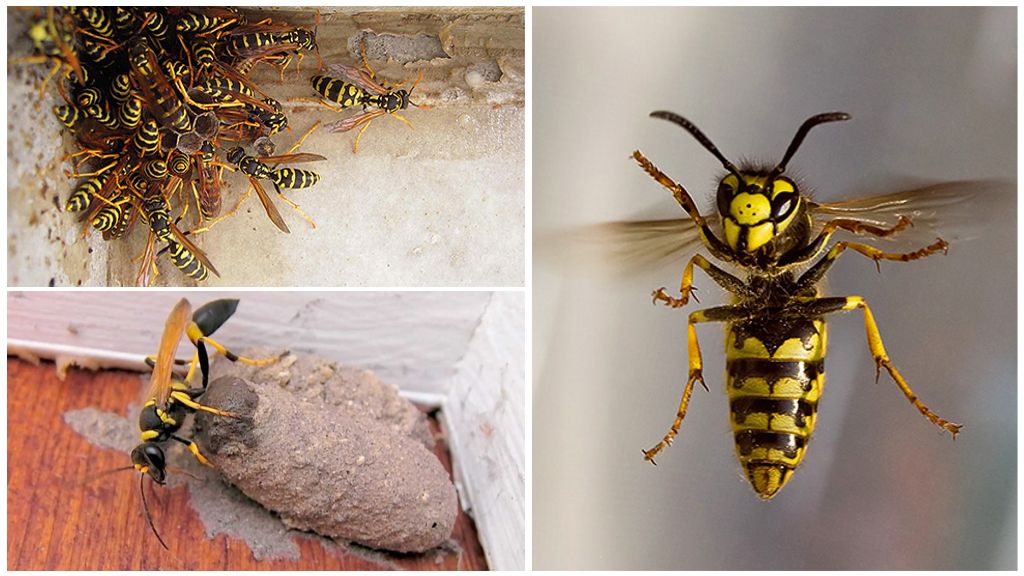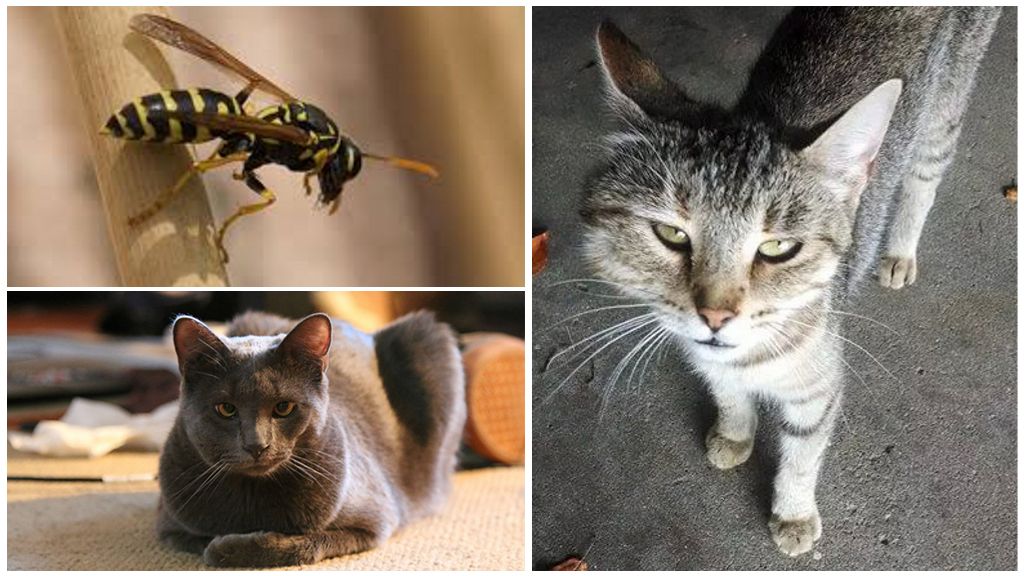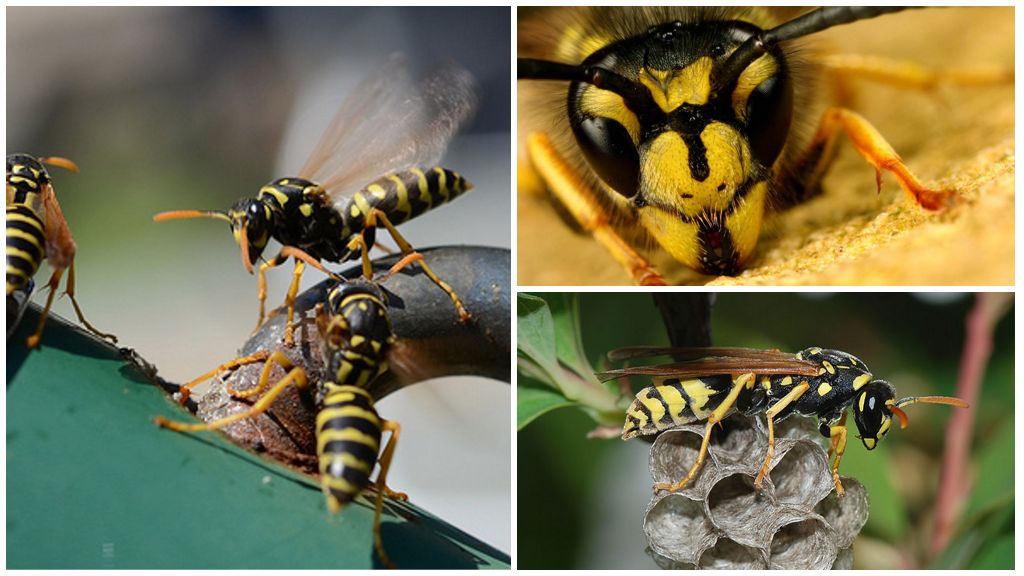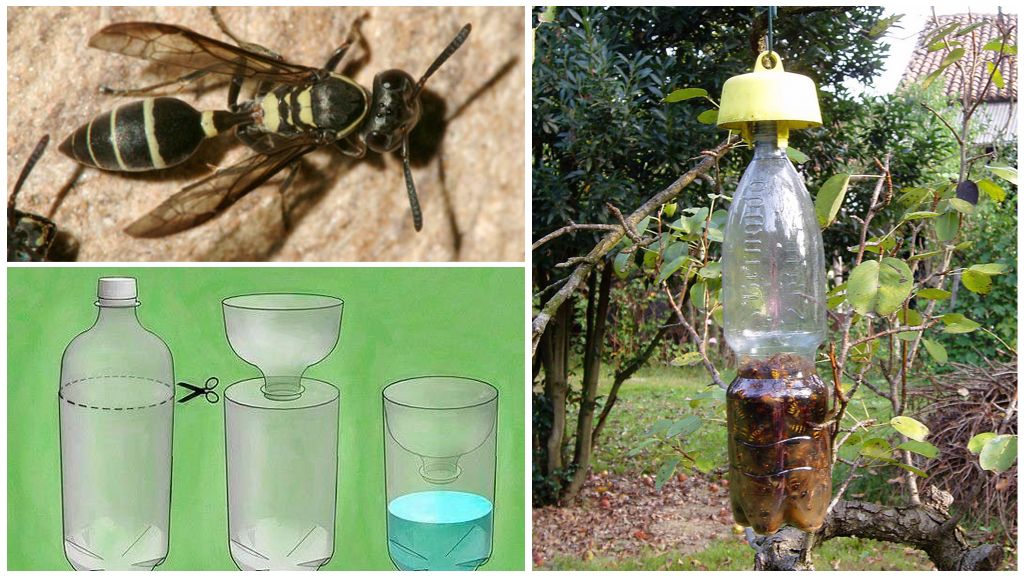- Wasp in the apiary
- Apiary trap
- Wasp Nest
Wasp control in the apiary is carried out if settled hornets, philants, they are bee wolves. If the hornets differ in appearance from other species of the aspen family in size, the bee wolf is difficult to distinguish from the usual paper wasp. In most cases, these varieties are fought, since paper wasps rarely make their way into the bee hive and kill weak, sick bees.
Wasp vs Bee
Apiary is bred for the sake of getting tasty, healthy honey. Bees work every day, collecting pollen. And then they turn it into a viscous aromatic mass. Honey serves as food for them, but also attracts the attention of wasps.
On a note!
Experts cite data that 50 large hornets in 3 hours destroy a bee family of 40 thousand individuals. They eat honey, larvae, and adult bees are taken away for feeding to their young.
No less harm is brought by the attacks of wasps, which were called bee wolves, in the apiary of bees. Advantages in size are insignificant, but aggressive disposition wins. Predators feel the apiary for several tens of kilometers, purposefully moving into the hive. After managing a swarm of pests, the beekeeper remains alone damages.
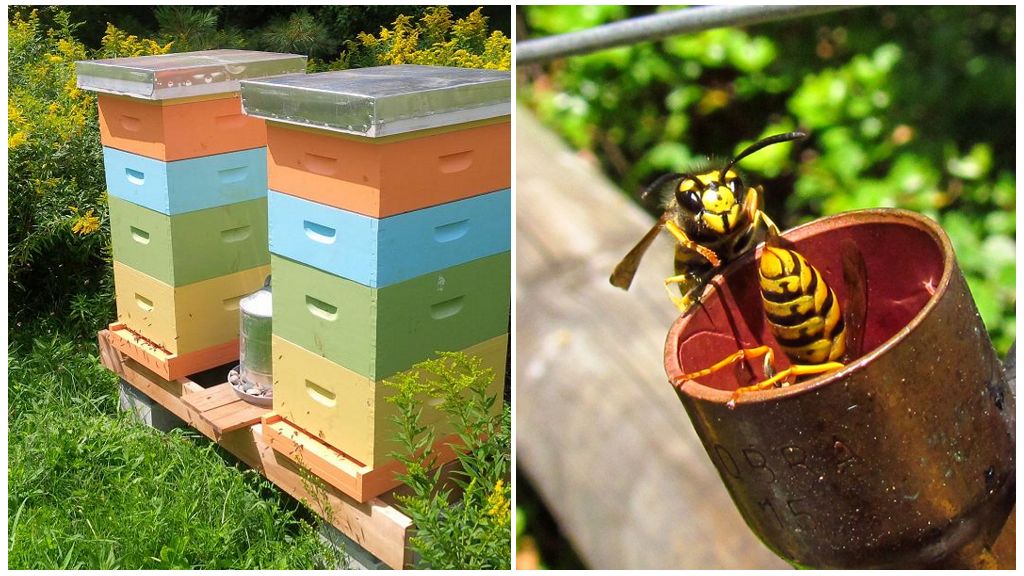
Paper wasps are less aggressive, but sometimes they also allow themselves to make regular raids on bee families. To avoid trouble, save the apiary, begin to care about the safety of insects in early spring.
Apiary Attack Prevention
In order to save the bee family, to ensure its apiary high productivity, you need to take care of the safety of the wards in advance.
- Correct arrangement of bee houses. You can protect the hive from wasps by the correct location of the apiary. It is recommended that beekeepers place houses on the territory where there are no ravines, embankments, vacant lots with sand. The soil should be dense, better chernozem, with a dense grass cover. Wasps filantas are sandy, digging holes in the soil, which lends itself well to this. If an apiary is located nearby, it becomes an ideal place for them. The location of the apiary, thought out to the smallest detail, will allow to avoid an attack of enemies in the future.
- Plowing the soil. In autumn, it is recommended to plow the ground in order to destroy the burrows of not only wasps, but also other potential enemies. Plowing the soil is one of the most important methods of fighting wasp wolves. In early spring, young individuals crawl to the surface of the earth, which continue to multiply, hunt for bees, their honey. Loosening the soil before the larva completes its development, guarantees a significant reduction in the number of enemies, makes it possible to destroy them in advance. It is necessary to rid the bees of their enemies before they even begin to launch an attack.
- Wasp traps. Traps from plastic bottles will help get rid of wasps in the apiary and prevent serious losses. They need to be done a lot, placed around the perimeter of the site. Hang on young trees, a fence, any convenient place. Cut off the neck, turn down, fix with adhesive tape, electrical tape, staples. Cut holes on both sides, thread the lace. Pour in the bait. Wasps love honey, jam, lemonade, juice, syrup, as well as meat that is carried for larvae.Several dozens of pests are caught in one trap per day. Protection needs to be updated periodically.
- Limited access. Many beekeepers use wasp control as limited access. In cold weather, when the bees are not yet very active, and their enemies feel great, you need to narrow the opening of summer in the hive. Leave a cut into which the bee will crawl freely, but the wasp will not pass. During the active summer, you need to expand the entrance so that insects can safely carry prey. To prevent wasps from entering the hive, they put special tubes of small diameter. They allow bees to move freely in any direction, and prevent enemies from climbing. This safe, convenient method will help save the whole apiary.
Destruction methods
You can fight wasps in the apiary with the same traps that are used for prevention. In this case, it is allowed not to hang around the perimeter, but to place it near the hives. Traps on wasps in the apiary are done very quickly. Cut a plastic bottle, pour 1 liter of water, kvass, beer, lemonade, juice. Wasp traps should be removed while pumping out honey, as bees can also get there. Periodically, you should get rid of the contents, update the bait.
Important!
For the destruction of wasps in the apiary, it is forbidden to use insecticidespoisonous bait. Since there is a high risk of bee poisoning. Hardworking insects are also not averse to feasting on juice, lemonade, kvass, sugar, where poison is often added.
Some beekeepers practice this method of fighting when they themselves are the bait. Extreme way that requires some patience. They put on a beekeeper’s costume, walk around the territory where wasps were seen. The smell of honey on the suit attracts them like a beehive. When several pieces are collected, spray on them with Dichlorvos. The insecticide will work even if it does not directly hit the body. However, it is necessary to carry out such a procedure away from the bees, otherwise they will die.
From the wasps near the hives, but only on the side where the honey carriers do not actively fly, they place an adhesive trap. The construction is not as effective as bottle traps, but it also helps to reduce the number of pests.
Search for enemy nests
You can protect bees from wasps by cardinal methods. If wasp regularly attacks the apiary, look for nest.
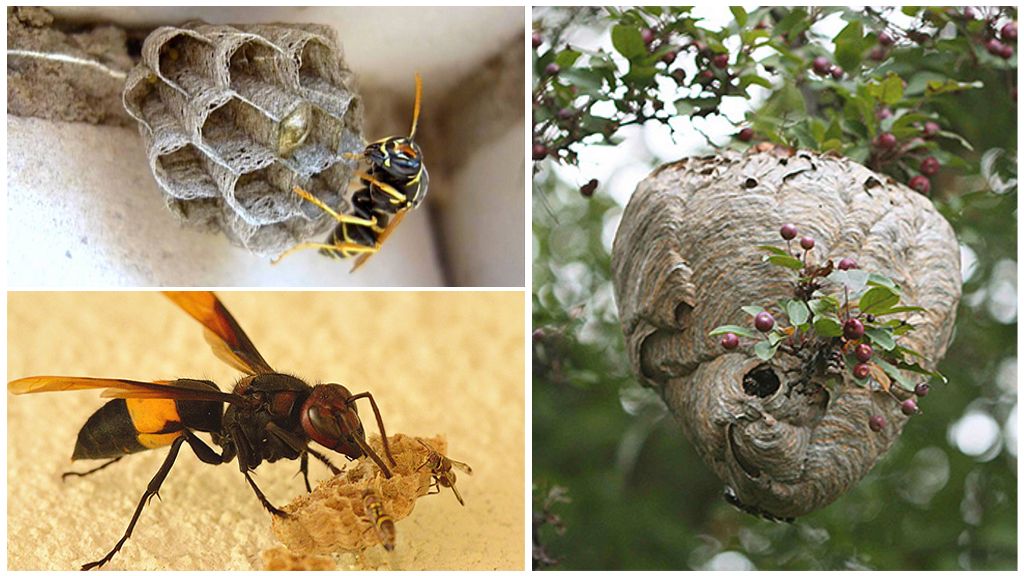
The bee wolf or European philant belongs to the sand wasp family. Each individual lives separately. Nests, as such, are not built. Burrows are made to drag the victim there, lay the egg, and provide larva with food for the entire development cycle. Adults feed on nectar, plant juices, and honey. Finding a nest of a philanthropist with one immobilized victim is impossible. The way out is to kill the wolves mechanically when they are found in the apiary. Periodically inspect the area.
Hornets are the largest representatives of wasps in our area, the main enemies of bees, smaller representatives of the aspen family. Hornets are public figures. Build huge nests, transmit each other signals of danger, finding food. If one hornet detects a beehive, there will be a swarm within an hour. Large wasps build nests on trees, in the ground, under stones, thickets, under the roof of outbuildings, in attics.
On a note!
Finding a hornet's nest is not difficult if it is located in the garden, vegetable garden, manor site. This is a large cocoon of gray-brown color, resembling a sphere of paper. There are several methods of destruction - they are poured with boiled water, polyurethane foam, doused with gasoline, then to burn, sprinkle poison or lay out the poison bait.
If ordinary wasps climb into the hive, make regular raids, you need to look for the nest of these insects, destroy them. Externally, the hive of paper wasps does not differ from the hornet house, the average size of the nest does not exceed the average apple.
Destroying an Aspen Nest
There are several methods. In most cases, use water, fire, smoke.
- If there is no desire to kill wasps, which also benefit nature, they pour a strong smelling substance on the nest - gasoline, kerosene, engine oil, but leave the entrance and exit open. After a few hours, the family will begin to migrate.
- Smoke has a deterrent effect. A fire is laid near the nest or the rubber is set on fire. Repeat recommended the next day. Dig an empty nest, remove, destroy.
- A barbaric but decisive method is the burning of nests. Suitable if the hive of wasps is placed in the ground. Pour with combustible substance, throw a match. In a minute there’s nothing left.
- Water. A nest in the ground is poured with a bucket of boiled water with soap. If the hole is large, repeat. When placing an aspen house on a tree, under a roof, in any other place on a hill, a cocoon is dipped in a bucket of water. Gently immersed in water, incubated for 20 minutes. Take off the cocoon.
If the hornet family has settled in the crevices of the house, garage, and inaccessible places, fill with mounting foam. The tool instantly stops the flow of air, all residents die. In the same way, you can quickly clog the entrance to the nest, which is located anywhere.
Fury wasp fight on the site, to destroy nests, to exterminate the family, it makes no sense if it’s not a hornet. Insects on the site destroy a huge number of garden pests, help people to keep the crop. Along with bees are the main pollinators of plants, bringing people substantial benefit.
